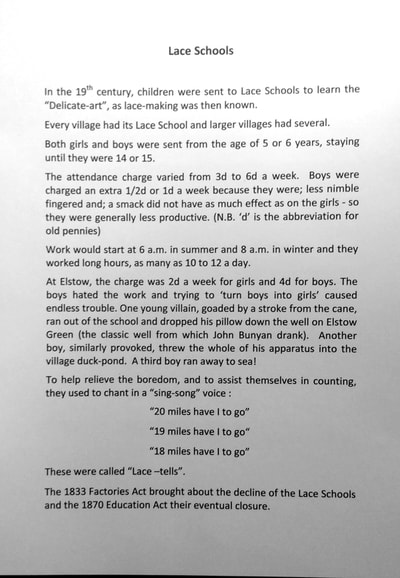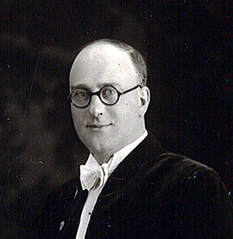Miscellaneous History Items
Buildings
Buildings
|
Articles about the timber-framed cottages
- Bunyan's Mead - on Elstow's High Street; |
| ||
|
Bunyan's Mead = Medieval panelling and paintings.
|
| ||
|
History of the Old Vicarage on Elstow Green;
|
| ||
|
History of the Elstow Pillbox
|
| ||
Engineering - Saunderson's Tractors
The Saunderson engineering factory was located on the North-West side of Cow Bridge, beside Kempston Road.
In 1898 Saunderson demonstrated a "Self Moving Vehicle" at a trial, organised at the Royal Show, which it unfortunately failed to complete because of engine failure.
It was priced at £250 but it is not known if any were sold. However, by the early 1900's production of 3 wheeled multi purpose tractors was proceeding and by 1910 4-wheeled models joined the range. Some of these were powered by Crossley engines. By the start of the Great War, conventional tractors were being produced just in time for the sales boom caused by the wartime labour shortage.
In 1922 they introduced a new light Tractor. This had a two-cylinder 'V'-formation petrol-paraffin engine. This was a 20 hp (15 kW) unit, giving 12 hp (8.9 kW) on the draw bar. The tractor had a 3-year warranty.
For a short time, Saunderson was Britain's biggest tractor makers. This success was not to last as the 1920's agricultural slump hit sales of all tractor manufacturers.
Crossley Brothers took over the business in 1924and the Saunderson tractors were rebranded as Crossley. As a result of the takeover, Crossley also entered railway locomotive making for one year, as work in hand included three petrol-powered locomotives for Beswicks Limeworks of Hindlow, Derbyshire.
The factory at Bedford continued in operation for many years making small stationary engines as well as agricultural machinery. It was sold in the mid 1930's and became known as the Bedford Plough and Engineering, the factory continuing to operate until the 1970's.
In 1898 Saunderson demonstrated a "Self Moving Vehicle" at a trial, organised at the Royal Show, which it unfortunately failed to complete because of engine failure.
It was priced at £250 but it is not known if any were sold. However, by the early 1900's production of 3 wheeled multi purpose tractors was proceeding and by 1910 4-wheeled models joined the range. Some of these were powered by Crossley engines. By the start of the Great War, conventional tractors were being produced just in time for the sales boom caused by the wartime labour shortage.
In 1922 they introduced a new light Tractor. This had a two-cylinder 'V'-formation petrol-paraffin engine. This was a 20 hp (15 kW) unit, giving 12 hp (8.9 kW) on the draw bar. The tractor had a 3-year warranty.
For a short time, Saunderson was Britain's biggest tractor makers. This success was not to last as the 1920's agricultural slump hit sales of all tractor manufacturers.
Crossley Brothers took over the business in 1924and the Saunderson tractors were rebranded as Crossley. As a result of the takeover, Crossley also entered railway locomotive making for one year, as work in hand included three petrol-powered locomotives for Beswicks Limeworks of Hindlow, Derbyshire.
The factory at Bedford continued in operation for many years making small stationary engines as well as agricultural machinery. It was sold in the mid 1930's and became known as the Bedford Plough and Engineering, the factory continuing to operate until the 1970's.
Events
|
Bunyan's Mead. 1976 restoration - 3 newspaper articles |
|
|
| ||||||
|
|
|
| ||||||||
Lacemaking
Other assorted pieces of historical information
The content of each item should, hopefully, be fairly obvious from its file name.
If not, click it anyway and see what you discover!
|
|
| ||||||
|
| |||||
|
|
|
| ||||||||
|
|
|
| ||||||||
|
| ||||
For an album of lace-makers' photographs click here - to go to the 'Old Elstow' album in our Picture Archive - the 'Lacemakers' section is about half way down that page.
People
|
Bowler and Berwicks
This Bowler family file contains the family tree of the Bowler family plus some photos and other information, including their connections to the Berwick. Roberts and Cirket families. It also includes information about Sarah Bowler, who was the 90 year old curator of Moot Hall in the 192os. Photos of Sarah can be found on these two pages: Old Elstow - Lacemakers and local people 1920s May Festivals |
| ||
|
Cirkets
This was another large local family. This image is of Clive Arnold's abridged version of their family tree. |
| ||
|
Coopers
The Coopers file contains an account of Elstow history by Joy Cooper-Watson. It includes information about her family. The Coopers are depicted making lace, in an album on this page. |
| ||
|
Cox Family
Ellen Cox (1905-1985) wrote an interesting account of her early life growing up in West End, Elstow. Ellen actually went to Sunday school in Moot Hall, before the Bunyan Memorial Hall was built in 1910 and was present at the opening of the new Bunyan Memorial Hall in 1910. |
| ||
Countess Judith - founder of Elstow Abbey - and her husband
Waltheof, Earl of Huntingdon and Northumbria
To learn more about these two, we recommend 'Of the ring of Earls' Juliet Dymoke Dobson Books 1970.
To read accounts written in Judith's time, download the 'Revolt of the Earls', document - link immediately below.
Waltheof, Earl of Huntingdon and Northumbria
To learn more about these two, we recommend 'Of the ring of Earls' Juliet Dymoke Dobson Books 1970.
To read accounts written in Judith's time, download the 'Revolt of the Earls', document - link immediately below.
|
|
|
|
| ||||||||||
|
Thomas Dun - Elstow's infamous 11th century son As well as being the birthplace of John Bunyan, who was famous for positive reasons, Elstow was also the birthplace of one of Britain's worst criminals and murderers - Thomas Dun. Joseph Bramwell Graham CBE
Bramwell Graham lived in Elstow Lodge from 1927 (soon after it was rebuilt in 1925) until May 1951. He was the clerk and solicitor to Bedfordshire County Council. By all accounts, he was well liked and respected. Every so often, he and his family would have to move out of Elstow lodge, to allow the visiting circuit Judges to stay there, whilst Beds County Court was in session. Bramwell worked closely with Sir Thomas Keenes, the chairman of Beds CC, on the CC's Festival of Britain committee. (See article 1/2 way down Moot Hall history page.) He, alongside Sir Thomas, lead the project to restore Moot Hall and to organise its grand opening in May 1951. Unfortunately, on Monday 28th May, just a few days before the scheduled opening day, Bramwell died of a heart attack. Sir Thomas suggested that they should delay the opening, out of respect for Bramwell but the family insisted that Bramwell would have wanted the ceremony to go ahead. For more biographical information; Beds Archive page Sir Samuel Luke of Cople
Luke was MP for Bedford and the governor of Newport Pagnell garrison, where Bunyan served during the Civil War. Samuel Whitbread of Cardington 1720-1796
|
| ||||||







